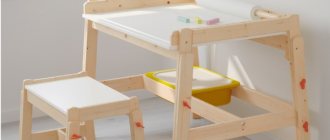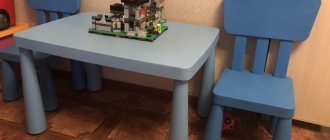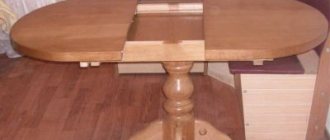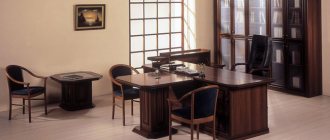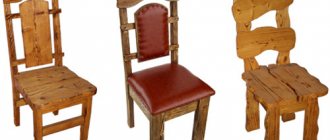Added by: Victor Kaploukhiy May 15
Every home craftsman knows that a well-equipped workshop with a stable and reliable carpentry workbench, equipped with all kinds of devices for processing parts, is half the success when making wood products. Of course, you can buy a desktop in a retail chain. However, we recommend making it yourself. Firstly, this will allow you to get a product of the desired size and functionality. Secondly, when building a workbench, additional equipment can be placed in the most rational way. Thirdly, the cost of the machine will be much lower than the factory version, which will allow you to buy a high-quality tool with the money saved. If these arguments have given you a reason to think about making a workbench with your own hands, then our drawings, instructions and recommendations will help you build a good-quality, reliable and functional carpentry workbench.
- 2 Types and design
- 3 Project and drawings
- 4 Necessary tools and materials
- 5 Manufacturing instructions
- 6 Installation of additional equipment
- 7 Video: Do-it-yourself carpentry workbench
Purpose and design of a typical carpentry workbench
A durable and reliable carpentry workbench will provide convenience and comfort during prolonged work with wooden parts.
A carpentry workbench is essentially a massive, reliable table for processing wood products of any size. The main requirements for equipment of this type are strength and stability. In addition, the machine must be equipped with at least a minimum set of devices for securing and holding workpieces. The dimensions of the workbench are selected depending on the size and weight of the parts being processed, as well as the available space in the workshop or garage. By the way, there are designs of compact workbenches that can even be placed on a balcony.
The design of a carpentry workbench with a stacked tabletop. In the figure: 1 - base or underbench; 2 - bench board; 3 - miter box; 4 - screed; 5 - vice; 6 - support beam
Since the work carried out on a carpentry machine is carried out using hand and electric tools, the workbench is made of solid timber and thick boards. By the way, the work surface, or in other words, the workbench board, is assembled only from hard wood. When making countertops, dry oak, beech or hornbeam boards with a thickness of at least 60 mm are used. If the tabletop is made of pine, alder or linden, then its surface will wear out quickly and will require periodic updating. Often, a workbench cover is assembled from several narrow and thick boards, placing them on an edge.
A series of holes made on the working surface of the table allows you to install thrust elements for easy processing of long wooden workpieces.
In order to facilitate the design, the supporting legs of the desktop, on the contrary, are made of soft wood. The vertical supports are connected to each other by a longitudinally installed beam to increase the stability of the product.
Typical diagram of a carpentry workbench
A vice of a special design is hung on the front and side of the workbench for fastening workpieces. In addition, on large-sized machines, separate clamping devices are installed for large and small parts. The optimal location for a carpenter's vice is the left side of the front apron and the near part of the right side panel.
In the underbench - the space between the supports, under the tabletop, convenient shelves and drawers are often installed for storing tools and accessories.
For convenience, a recess is made in the back of the tabletop for fittings and small parts. Often, a difficult-to-manufacture recess is replaced with a frame made of wooden slats.
Wood-metal workbench
Let's figure out how to make a bench with dimensions of 2.2 m * 0.75 m * 0.95 m and six drawers (three on each side). For work, in addition to tools and sheets of plywood, you will need a two-millimeter profile pipe with dimensions 6 cm * 4 cm:
- 3 pieces of 2.2 m for both sides of the table top and the lower rear stiffener of the workbench;
- 6 pieces of 0.75 m each for the other two sides of the tabletop (end), as well as to form a frame for retractable drawers;
- 4 pieces of 0.95 m each for the legs of the workbench table;
- 5 pieces of 0.7 m each for assembling frames intended for drawers, as well as for the jumper (foot rest).
To make a workbench out of wood and metal, you need to start by assembling the basic structure. To do this, you will need to weld the future tabletop from two long corrugated pipes and two 75-centimeter ones. At the second stage, four legs are attached to the corners of the structure in the same way (in this example they are 95 cm long). At the next stage, you need to weld the third long pipe at the bottom, in the back of the product so that it is parallel to the floor, 25 centimeters above it.
Types and design
All homemade work tables for carpentry work can be divided into three types:
- Mobile workbenches have a weight of up to 30 kg, dimensions of less than 1 m in length and up to 70 cm in width, are equipped with only a vice and are made partly from metal elements. Such machines are intended for working with small, lightweight workpieces or minor repairs of wooden products. A mobile desktop is an excellent option if there is a lack of space and can be installed in any room in the country house or on the balcony. Often, mobile workbenches have a folding design.
Homemade carpentry workbench with mobile designIf there is no need for a stationary, professional workbench, then for minor repair work or the manufacture of small parts you can convert an old desk.
- A stationary carpentry workbench is made with reference to a specific location and is not intended to be moved during operation.
Equipment of this type allows you to process parts of any size and weight. A stationary carpentry workbench is a reliable, stable structure, arranged in accordance with the preferences of the owner and the characteristics of the room - The compound type machine is the most difficult to manufacture.
However, due to its variability, this design is the most practical and functional structure. If necessary, individual parts of the workbench can be easily replaced, since the elements of the workbench are connected to each other by bolted joints. A composite workbench is a structure that can be adjusted to any requirement
Combining parts
The main properties of a workbench for the home:
The surface of the device is made of wood. For these purposes, dry planks with a thickness of 5–6 cm are selected. It is best to use wood that has been pre-treated with drying oil. Otherwise, the workbench tabletop will not last long.
Edged board for workbench
A vice is attached to the cover of the structure, which will fix the items being repaired.
It is preferable to make large vices from wood, and small ones from metal. If the length of the workbench exceeds 1 m, several vices of various sizes can be installed on its working surface.
Vise design
The legs of a carpentry workbench are made from boards of other wood species (maple, linden, pine). They are connected to each other by strips located longitudinally. This ensures reliability of the design.
The space under the workbench tabletop can be used rationally by installing pull-out drawers or shelves for storing work tools.
Workbench with built-in drawers
Recesses are made on the surface of the structure in which heavy items for repair will be fixed.
It is recommended to drill a hole on the back of the tabletop for repairing small parts.
Project and drawings
When developing the design of a carpentry workbench, the most important criteria are height, configuration and equipment. In addition, it is necessary to take into account who will use the desktop - left-handed or right-handed.
Considering that you will have to work at a carpentry bench for a long time, the closest attention should be paid to the height of the future structure. For people of average height, experts recommend making a table no higher than 90 cm.
Drawing of a carpentry workbench
When determining the distance from the floor to the tabletop, it is best to focus not on average parameters, but on the features of your own anatomy. It is optimal if the upper cut of the legs is at the same level as the hands. If you calculate this parameter taking into account the thickness of the tabletop, then you will be able to work tirelessly at such a workbench for several hours.
The machine cover can be made of boards, solid wood or plywood and is a composite structure. It is not recommended to use chipboard or OSB for these purposes. Professional carpenters have long determined the optimal size of the tabletop - a maximum of 2 m in length and 0.7 m in width. On such a workbench, you can make both a prefabricated wooden door and a small window with equal convenience.
When designing a structure, do not forget about the strength of the supporting frame. For supporting elements of the structure, timber with a cross-section of at least 100x100 mm is used. As longitudinal and transverse reinforcing elements, it is allowed to use slats and beams with a smaller cross-section - from 50 - 60 mm or more. The joints of the parts are mounted on tenons or dowels; furniture corners and other fittings are used for strength, and all connections are made using bolts and self-tapping screws. Nails will not be able to provide the required stability and fundamentality of the structure.
Carpentry workbench. View from above
Often the frame, or otherwise the workbench frame, is made of metal. Despite the fact that this material makes it possible to create a height-adjustable structure with less labor, professional carpenters prefer all-wood structures.
Next, let's look at a project for a carpentry table made from plywood, or more precisely from two plywood sheets 1.8 mm thick glued together. The dimensions of the lid are 150x60 cm. The edges of the tabletop are reinforced with plywood strips, which increases its thickness to 72 mm. By the way, the presented dimensions are not a dogma and can, if necessary, be adjusted in accordance with the needs and characteristics of the specific room used as a workshop.
Video description
This video shows the process of making a carpentry workbench:
At the last stage of assembly, you need to sew up the back and sides of the workbench table with plywood, and also make a tabletop. If you decide to make the top from wood materials, you can use several sheets of plywood securely glued together. To obtain a more reliable, durable bench, you can install a two-millimeter metal sheet as a tabletop. To store tools and various materials that may be useful to a craftsman in his work, it is worth making shelves or drawers for the workbench.
Required tools and materials
Plywood with a thickness of 18 mm is a fairly expensive material (the price of one sheet measuring 1.5x1.5 m is more than 700 rubles, excluding delivery costs). Our project will require at least two sheets of this material. You can save a little if you buy one, larger sheet measuring 2500x1250 mm. Additionally, if possible, try to purchase scraps of plywood at least 300 mm wide, which will be used to reinforce the workbench cover around the perimeter.
Additionally, to build a carpentry machine you will need:
- wooden beam with a cross-section of at least 100x100 mm - for supports;
- timber or slats with a cross-section of at least 60x60 mm - for frame reinforcement elements; When choosing lumber for a carpentry workbench, carefully inspect the workpieces for the absence of knots and cracks. Remember that these parts will be subject to prolonged load;
- electric drill with a set of regular and feather drills;
- pieces of boards at least 1.5 m long for placing under clamps;
- wood glue. A good result can be obtained by using the domestic adhesive composition “Moment Joiner”;
- furniture bolts with nuts and self-tapping screws;
- Circular Saw;
- carpenter's square;
- long rule (at least 2 m);
- construction level;
- a notched spatula with the size of the cut sectors not less than 3 mm;
- carpentry clamps.
The clamps needed to compress plywood sheets when gluing must be strong and reliable. If you are a non-professional carpenter and do not have high-quality tools, then you can get by with inexpensive Chinese-made clamping devices. Of course, the number of such devices should be doubled.
Use of building materials
- Planed timber is considered a universal building material for making a desktop. The size of the legs of the structure is usually 7x10 cm.
Workbench legs made of planed beams
- An old unnecessary door can serve as a workbench cover. The thickness of the boards used for the tabletop should be about 5-6 cm.
- Before making the device, you need to decide what type of workbench will be - stationary or collapsible. Based on this, the fastening is selected (bolts, screws, nuts, nails).
- It is advisable that the workbench has several vices. One can be installed on the side and the other on the front. Vices are convenient because they fix products intended for processing. The universal width of the vise jaws is 5 cm.
Attaching a vice to a workbench
Manufacturing instructions
- To make the tabletop, cut two pieces with a circular saw. If you managed to purchase a plywood sheet of maximum length, then you need to saw off one piece 1520 mm long from it. By cutting it in half, you will get two parts 1520x610 mm. After this, use the rule to check the concave and convex sides of each sheet. This will make it possible to correctly orient the sheets when gluing.
High-quality gluing ensures clamping of tabletop parts with clampsTo properly glue plywood sheets, they are folded with their convex sides facing each other.
- Having laid one workpiece on three parallel boards, apply wood glue to its surface.
To do this, use straight and notched spatulas. Remember that the work must be carried out very quickly, otherwise the composition will begin to set prematurely. recommends connecting the parts no later than two minutes after the start of applying the composition. Therefore, if you are not confident in the speed of your work, use wood glue, which has no time restrictions. Of course, the strength of the joint will be slightly reduced, but even a good quality PVA furniture mixture will provide an acceptable degree of adhesion. To avoid damage to the workpiece, support boards are placed under the clamps - Having laid the second blank on top of the first, place support boards around the perimeter of the future table top and begin to tighten the table top with clamps. At the same time, do not forget to control the flatness of the part using a rule. It will not be possible to tighten the center of the workpiece with clamps, so in this part you can install a load weighing at least 15 - 20 kg.
You can glue plywood sheets into a board without clamps, if you can find a perfectly flat surface for laying them, as well as a load of sufficient mass.
- After the glue has dried, the clamps are removed and they begin to strengthen the side surfaces of the tabletop.
To do this, strips of plywood 15 cm wide are glued along the entire perimeter of the lid in two layers. When performing this work, be sure to make sure that the top layer completely covers the joints. Reinforcing the side parts of the workbench with additional plywood strips - A circular saw is used to trim the side surfaces of the table. The parquet is driven smoothly, slowly. It is convenient to use the same rule as a guide. The tabletop is given a size of 1500x600 mm, observing right angles, for which they use a carpenter's square or a factory corner of a plywood sheet.
- The workbench supports are made of timber with a cross-section of 100x100 mm, connecting them with legs and drawers, for which lumber with a cross-section of at least 60x60 mm is used.
In our case, the height of the machine is 900 mm, however, you can adjust this size to suit your height. Making a carpentry workbench frame - The legs are assembled “in a tenon” or using dowels, making sure to apply wood glue to the parts to be joined.
- When assembling the upper and lower frames of the subframe, scrupulously maintain 90-degree angles between the parts.
It will be easier to fulfill this requirement if, even at the stage of preparing the parts, their edges are trimmed correctly. The width of the frame of our structure is 900 mm, and the height of the frame is 830 mm, taking into account the distance from the floor to the bottom rung of 150 mm. Assembly of the subbench - To attach the table top to the bench, long drawers are drilled in three places, through which the workbench parts are secured with 8 mm self-tapping screws with a length of at least 100 mm.
Installation of a tabletop on a benchtop - To prevent the head of the hardware and the washer from protruding beyond the support elements, a recess is made in them with a feather drill.
Holes made in the parts with a feather drill will help hide the bolt heads and washers.
If desired, you can build a shelf in the bench. To do this, a plywood panel is cut to the size of the lower space, in the corners of which rectangular cutouts are made for the legs of the machine.
Preparatory work
Creating a drawing of a workbench is an obligatory part of the preparatory stage
Preparation for assembling a workbench consists of determining the design features, choosing the dimensions and installation location of the structure. In order to ensure that not a single moment escapes attention or is forgotten, it is recommended to create a working drawing of the workbench, made to scale with reference to the size of the garage
Particular attention should be paid to the height of the tabletop - it differs significantly from the height of a regular dining table. The optimal option is the height from the floor to the bend of the elbows of a person standing straight
Considering the difference in height between different people, assembling the optimal workbench for yourself can be a very useful exercise.
In addition, we must remember that the width of the tabletop should not be too large. The size of the garage is relatively small; you often have to work next to a car parked inside.
You will need space for a person to pass through, so the optimal width is considered to be 50 cm. You also need to decide on the size of the shield for the tools that are needed most often.
Materials and components
As you can see, workbenches vary greatly in design, and the materials can be very different. Usually these are what you have in the garage, but they can also be purchased.
For example, to make the frame of such a workbench you will need:
- corner 50x50x4 6.4 m long;
- pipe 60x40x2 24 m long;
- corner 40x40x4, length 6.75 m;
- strip 40x4 8 m long.
A total of 121 kg of metal is needed. Its quantity may vary depending on the size.
For this model you will need:
- 225 m square pipe;
- 8 m corner;
- 10 m strips measuring 40x4 mm.
Rental sizes may vary. The main rule is that the larger it is, the stronger and heavier the structure.
This thick section can be small and used as an anvil, while the other part of the tabletop can be relatively thin. The main thing is to ensure the reliability of the connection.
Consider other points as well.
- For the drawers and toolboard you will need plywood 5 mm thick. And if you want to make an outlet, you will need an extension cord and wire.
- In addition, bolts with washers and nuts are needed.
- For finishing work you need a primer, paint and varnish.
Required Tools
To make a workbench we will need:
- “grinder” or hacksaw for metal;
- cutting and sanding wheels for it;
- wood saw;
- welding machine and accessories;
- drill;
- roulette;
- chalk for marking.
Once everything is ready, we begin production.
Drawings and dimensions
To assemble a high-quality workbench for the garage, you must first decide on its dimensions. When drawing up a drawing, special attention should be paid to the height of the tabletop. The optimal option for this indicator is the distance from the elbow of a standing person to the floor.
The width should not be too large. This is due to the limited size of the garage and the need to often work when a car is parked inside the room. Space will be required for people to pass through, so the optimal width of the structure varies from 50 to 80 cm.
Installation of additional equipment
It is impossible to imagine a real carpentry workbench without devices designed for fastening the workpieces being processed. For these purposes, a vice is attached to the finished tabletop in such a way that its jaws are flush with the surface of the lid. To correctly install the device on the workbench, apply a vice to the machine and mark the fastening points. After this, holes with a diameter of 12 mm are drilled and the tool is installed on the machine using a bolted connection with an M12 thread. When performing this operation, be sure to mill holes for the washers and bolt heads.
View of the finished product with a vice installed
If it is not possible to install a stationary vice, you can do without them by using bench clamps or clamps.
In addition to the vice, there are stops on the work table. To do this, a series of holes are drilled in the tabletop. The best stops are considered to be parts made of wood, since metal devices can damage the workpiece. The sockets for the supporting elements are located at a distance equal to half the stroke of the vice. This will allow you to securely secure a workpiece of any size.
Types of vices
Before choosing a workbench, you need to find out what kind of vices exist for these devices.
The vice is designed for fastening workpieces to the structure. To ensure the efficiency of the work process, special grooves with wedges are installed on the workbench lid, thanks to which the bars are attached.
The properties of the vice depend on the specifics of the work.
The following types of fasteners are distinguished:
Chair vice.
The vice gets its name because it is attached to a chair-shaped base. They are designed to perform heavy duty work. They are used very rarely.
Chair vice
Hand vice.
They, in turn, come in three types:
– instrumental;
– rotary;
– non-rotating.
For rotary and fixed vices, the width of the jaws is approximately 80 mm.
Hand vice
Universal vice.
They are used for fastening small workpieces.
The universal vice is fixed to the workbench tabletop using mounting bolts.
Universal vice
Special vice.
They are convenient because they can be easily rotated in any plane and adjusted both vertically and horizontally. This allows you to position and fix the element for processing at your own discretion.
Special vice
Video: Do-it-yourself carpentry workbench
Building a carpentry workbench is quite a difficult task. However, a self-assembled machine will allow you to work in a convenient, comfortable environment. This requires not only to think through the ergonomics of the workspace and correctly prepare a construction project, but also to carry out the work in full accordance with the recommendations of professional carpenters. Only then will the resulting product be durable and stable, pleasing its owner for many years of service.
- Author: Victor Kaploukhiy
Thanks to my varied hobbies, I write on various topics, but my favorites are engineering, technology and construction. Perhaps because I know many nuances in these areas, not only theoretically, as a result of studying at a technical university and graduate school, but also from the practical side, since I try to do everything with my own hands. Rate this article:
- 5
- 4
- 3
- 2
- 1
(24 votes, average: 4.1 out of 5)
Share with your friends!
Plywood table: advantages, types, production
I just took it apart, worked on it, and put it away. The author has thought out devices for working with length gauges. Despite its compactness, the table is capable of a lot. The successful use of stiffening ribs in the design makes the table quite light, but at the same time durable.
Further from the author in machine translation.
Additional Tips
In order to make the furniture look more aesthetically pleasing, you need to hide some of its parts. For example, the edge of a tabletop looks ugly if you don’t put a special construction edge along it. It will not only hide imperfections, but also extend the life of the table. Moisture that may get on the tabletop during operation will quickly destroy it, and the edging will protect it from this problem for a long time.
The edging gives the table a finished look
Be sure to varnish the entire finished structure, even if you have already done it disassembled. This coating hides all the imperfections that arise during the assembly process, and also strengthens the protective properties of the material. Even if you decide to paint it any color, do not skimp on the varnish, the shade of the paint will only become brighter.
The material from which the countertop is made must be durable and preferably new. Even small cracks will greatly reduce its service life, and chips will ruin its appearance. With the right approach, you can assemble the finished product in one day, and for those who already have carpentry experience, sometimes a few hours are enough.
Table assembly
You should start assembling a plywood table from the legs. This is the basis that should firmly hold the finished product. You can fasten them with a screwdriver, but it is advisable to additionally coat the joints with glue, it will allow the parts to be fixed more firmly. Remember to be sure to follow the diagrams that you must prepare in advance. Any deviations threaten that the structure will soon become loose and cease to perform its functions.
The tabletop is attached according to pre-marked patterns. If you later decorate the surface, you can attach it to the top with a screwdriver. To ensure that the surface remains completely clean, you can attach the tabletop from below to construction corners.
As a result of the work, you will be able to make sure that making furniture at home is not only quite economical, but also interesting. And your loved ones will probably like the completed project.
How to make a table from plywood
After the tools, materials, drawing, and templates are prepared, it’s time to begin the process of creating the table. To do this, follow the instructions.
Part marking
Take a cardboard template, secure it to a plywood board with masking tape, and trace it with a pencil. Thus, it is necessary to outline all the components of the table , starting with the tabletop and ending with the legs or side stands that replace them.
Cutting out parts
To do this, use a jigsaw or circular saw . It is easier to cut a triangular or square shape than a curved one. But the latter can also be dealt with using patterns.
Surface treatment
We are talking about grinding elements using sandpaper or another grinding tool.
Important! The joints are subjected to the most careful processing. They must be absolutely smooth so that the parts fit together as well as possible.
Connection of product components
Mark with a pencil the location of the fasteners. Drill holes in these places using a drill with a diameter slightly smaller than the screws. Then process the top of the resulting holes with a drill with a large diameter - this process is called countersinking.
Then connect all the components. Make sure that the joints are tight - then the table will last a long time. Place caps on the heads of the self-tapping screws.
Safety requirements for a homemade workbench design
Any design must first be safe, and then functional and practical.
Working on a workbench carries potential danger, so it must meet the following requirements:
- The workbench must be securely fixed to the floor and not wobble during work.
- A table covered with sheet steel must be equipped with a protective mesh at least 1 meter high, running along the entire length of the workbench.
- The workplace should be designed conveniently and ergonomically: everything is at hand and nothing interferes with the work process.
- The corners of the tabletop should not have sharp edges.
- The wedges in the holes should be attached firmly, but not so tightly that the edges do not chip. The holes are made the same size.
- The screws are well lubricated to ensure smooth movement of the workbench running parts. They are made of metal, less often wooden
- At the end of the work, they should be loosened slightly and kept loose.
- The surface of the tabletop is sanded; it is important to achieve smoothness and absence of defects. The working surface must be constantly cleaned of chips and oil.
- Keep the floor near the workbench clean, otherwise injury may occur.
- The jaws of the vice must have soft gaskets to ensure reliable fixation of the workpieces.
- When using multiple vises, they should be spaced at least one meter apart.
- It is necessary to use vibration-damping rubber pads when working with power tools.
- You should not place hot things on the workbench, spill water on them, or place heating appliances near it.
- When drilling, sawing and other work that can damage the surface of the tabletop, you should place a protective board under the workpiece.
- A properly designed workbench can withstand a load of about 200 kilograms.
Important! The master must also remember about his safety. The workplace should be well lit, the tools should be in good working order, the vice should be equipped with an unworked notch and the parts should be firmly secured
You should work in special safety glasses.
More advanced requirements for work tables are described in GOST 20400 and GOST 22046. The workbench must meet all safety requirements and only after all conditions have been met should you start working.
